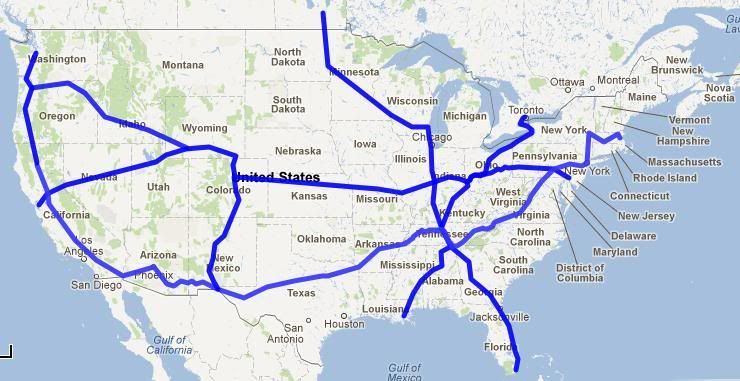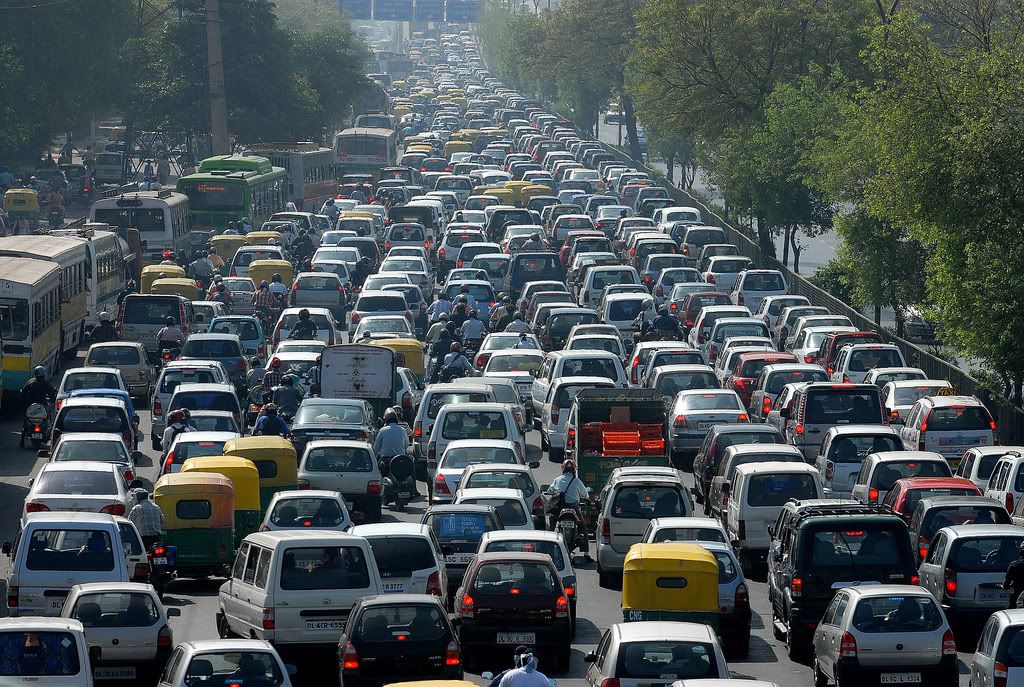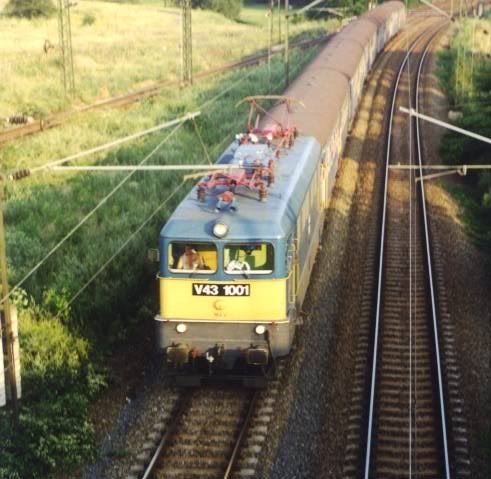(2 pm. – promoted by ek hornbeck)
Burning the Midnight Oil for Living Energy Independence
 The last two weeks on the Sunday Train, I’ve been writing about the Steel Interstate. Steel Interstates & An America That Can Do Big Things (3 June) revisited the basic concept, and Putting Steel into the Amtrak Long Distance Backbone primarily discussed the first third of the Congressionally mandated reports on improving Amtrak’s long distance rail network, but also discussed a bit about the role of long distance trains in the context of the Steel Interstate proposal.
The last two weeks on the Sunday Train, I’ve been writing about the Steel Interstate. Steel Interstates & An America That Can Do Big Things (3 June) revisited the basic concept, and Putting Steel into the Amtrak Long Distance Backbone primarily discussed the first third of the Congressionally mandated reports on improving Amtrak’s long distance rail network, but also discussed a bit about the role of long distance trains in the context of the Steel Interstate proposal.
This week, the attention shifts from the Steel Interstate infrastructure to the substantial benefit to our existing legacy Asphalt Interstates if the United States elects to retain a viable national economy by implementing some form of Steel Interstate electric rapid freight rail system for long-haul freight.
Along the way, I spend a bit of time talking about misconceptions about the cost of our legacy system. Myth and misconception that are sufficiently widely help may be sufficient platform for gathering majority support for a system … but its not a sufficient platform for putting together a sustainable system, in either physical, ecological, economic, or financial senses of “sustainable”.
What The Big Highway Lie Is Not, Part I
 There are some people who labor under the misconception that gas taxes fund highway maintenance cost.
There are some people who labor under the misconception that gas taxes fund highway maintenance cost.
The notion is quite absurd on the face of it. The share of the federal highway fund that goes to roadworks is greater than the share of driving that takes place on funded highways, so obviously driving on unfunded streets … mostly urban and inner-suburban city streets … yields gas taxes that cross-subsidize driving on funded highways.
For example, here is the 2008 FHA Highway Statistics on highway revenues as a percentage of total disbursements:
- 46.61% Motor Fuel and Vehicle Taxes
- 5.11% Tolls
- 4.57% Property Taxes and Assessments
- 22.19% General Fund Appropriations
- 9.60% Investment Income and other Receipts
- 10.95% Bond Issue Proceeds
Of course, the gas tax and vehicle tax revenues are collected for all road uses, and only directed to qualifying highways. While qualification of urban streets for state gas tax funding varies by state, urban streets that do not qualify for national or state highway designation are excluded from federal highway gas taxes.
Of course, over half a century of subsidy has channeled traffic onto these federally funded highways (that is, Interstate, National, State, County and Township highways), but still, according to the introduction to the 2011 CBO report on alternative approaches to highway funding:
About 25 percent of the nation’s highways, which carry about 85 percent of all road traffic, are paid for in part by the federal government.
… so the direct gas tax and vehicle tax proceeds from driving on federally funded highways is at most 85% of 46.61%, or about 40%.
And, of course, this is also a substantial overstatement, since that is about 15% from Federal gas taxes and about 25% from state gas taxes. And in most states, gasoline is exempt from state and local sales taxes, so that only a portion of state gas taxes are an actual additional user fee, with much of the state gas tax simply being a diversion from the general fund. It would be as if alcohol sales in a state charged a “drinks tax” which went into providing infrastructure in support of drinking parties ~ and were exempted from state sales tax.
I don’t have any recent figures on how much of total state gas tax revenues is an increment over what would be the sales tax proceeds on sales tax exempt gasoline sales, and how much is a diversion, but if the additional user tax component is between 40% and 60% of total state gas taxes, then total “farebox cost recovery” of the highway system is between 30% and 35%.
While “nobody serious seriously believes that gas taxes fully fund our nation’s highways”, anybody who has read the Tea Party Parade that fills many online newspaper comments sections when a rail project is covered knows that lots of people are happy to make the absurd claim.
Now, that absurd claim is simply wishful thinking. It collapses immediately when presented with the publicly available Federal Highway Administration figures. The fact that it is confidently stated by so many serves to establish how many people are happy to state facts that are blatantly false, often passed on from someone else equally misinformed because it sounded like something that ought to be true.
But while it is, obviously, a Highway Lie every time it is presented, its is not the Big Highway Lie.
What The Big Highway Lie Is Not, Part II
 Last year, the New America Foundation was among those covering the most recent efforts to raise the alarm over the Infrastructure Deficit in the US. As it reported:
Last year, the New America Foundation was among those covering the most recent efforts to raise the alarm over the Infrastructure Deficit in the US. As it reported:
How big is the infrastructure deficit given our needs?
The American Society of Civil Engineers (ASCE) estimates [pdf]the U.S. needs $2.2 trillion dollars of infrastructure spending during the next 5 years, of which $1.18 trillion has not been budgeted.
…
The Federal Highway Administration (FHWA) estimates that we must spend $105.6 billion annually from 2007 to 2026 to sustain current conditions and performance. To improve conditions annual expenditure could be up to $174.6 billion. The National Bridge Investment Analysis System (NBIAS) estimates $98.9 billion should be invested immediately to repair bridge deficiencies. The Highway Economic Requirements System (HERS) model estimates that $523.5 billion could be spent on roads and highways based on poor current conditions and operational performance. Across many modes of infrastructure, impacting every sector of the economy, there are significant needs for infrastructure repairs and upgrades.
… and the farebox recovery ratio above is not a ratio of physical cost imposed upon the highway system by driving, but a ratio of revenues to our inadequate highway spending. From the ASCE report cited above (p. 99), 5yr road spending of $380.5b can be set against total investment needs of $930b, for a 59% shortfall. So ASCE reckoning implies a physical cost recovery ratio of 12% to 15% for our highway system.
However convenient those physical cost recovery ratios may be, in my view the American Society of Civil Engineers is overstating investment needs, based on a fundamental flaw in reasoning:
Next to safety, congestion has become the most critical challenge facing our highway system. Congestion continues to worsen to the point at which Americans spend 4.2 billion hours a year stuck in traffic at a cost of $78.2 billion a year in wasted time and fuel costs-$710 per motorist. The average daily percentage of vehicle miles traveled (VMT) under congested conditions rose from 25.9% in 1995 to 31.6% in 2004, congestion in large urban areas exceeding 40%. And as a result of increased congestion, total fuel wasted climbed from 1.7 billion gallons in 1995 to 2.9 billion gallons in 2005.
Since spending on roadworks does not alleviate congestion over the long term, road “investment” justified on the basis of the “need” to alleviate congestion is akin to bleeding a patient again because they are still weak, despite already having been bled several times before.
However, the ASCE report (p.99-100) cites the work of the The National Surface Transportation Policy and Revenue Commission, which estimated $130b required annually per year to maintain “key conditions and performance measures at current levels, …”. This implies that expected spending is 59% of system maintenance needs, and “only” 41% short. So a more reasonable physical cost recovery ratio would be 17% to 21%.
Lots of “serious” people neglect the difference between the cost of driving in terms of the requirement imposed on system maintenance and the funds directed to maintenance, but the reality is that even as we proceed with building new roads, and new lanes, we are running down the system that we have. As a nation, we are treating our nation’s road infrastructure like the Penn Central railroad treated its railway network in the 50’s and 60’s, running it down, every once in a while drawing up an unfunded plan to catch up on deferred maintenance, and then running it down some more.
But while portraying the spending on maintenance as equal to the maintenance cost of our highway system is a Highway Lie every time it is presented, its is not the Big Highway Lie.
The Big Highway Lie
The big highway lie is assumed throughout the critique of the two smaller highway lies above. The big highway lie is:
- the cost of supporting the motor vehicle transport system is the cost of maintaining our road system
The Big Highway Lie is, in other words, assuming that the only “public” cost of driving is providing a road system. Consider the data originally from Douglas Lee (1995) on the full cost pricing of highways for the Volpe National Transportation Systems Center (presented in Transportation Cost and Benefit Analysis II – Literature Review (p. 2-6), estimating highway costs not recovered from users, include highway maintenance, administration, parking, disposal of scrapped and abandoned vehicles, pollution from tires, used oil and lubricants, and toxic materials, the Strategic Petroleum Reserve, tax subsidies to oil production, public medical costs from accidents, uncompensated losses from accidents, air pollution, water pollution, noise pollution, cost of noise barriers, and the tax transfers already discussed in part above in the state and local sales tax exemptions, but also including the Federal gasohol exemption, Federal corporate income tax exemptions, and local government property tax exemptions.
Out of $382b in costs associated with highways, user revenues were $52b. Notable external costs remaining after direct costs of new highway construction, highway maintenance, and $38b in tax transfers are taken out, which exhausts direct user revenues several times over, include (and remember that this was a 1995 study):
- ~$68b parking
- ~$68b pollution
- ~$14b accidents
- ~$15b in administration, research and traffic police
And that cost of accidents was the external, financial costs of accidents, and omits the costs to motorists themselves.
Since this was 1995, the greenhouse gas emissions impact is entirely omitted, and even with that emission, the full cost recovery is under 14%. And since this was a 1995, the full cost recovery figure will be even lower today, as the Federal gas taxes are not indexed to either general, consumer price, or construction cost inflation, and the costs of road maintenance have risen substantially faster than the the growth in fuel tax revenues.
Steel Interstates and the Big Highway Lie
(1) Not only do highway gas taxes not fully pay for our highways,
(2) Nobody actually fully pays for our highways, since we are running down the system, and
(3) covering all highway costs would still leave shift the majority of the public costs of driving onto the third party victims of driving.
However did we build up this system in the first place? Well, for one thing, the gasoline tax, corrected for inflation, used to be higher. And for another thing, the cross-subsidy from unfunded streets and boulevards used to be much larger, as in the 1950’s a majority of driving occured on unfunded streets. And for a third thing, when we were just building the system, the highway maintenance bill was smaller, since we had fewer highway lane-miles to maintain.
But we’ve built up a system that we cannot “afford” to keep, at least based on our willingness to pay. So we have to do one or both of two things: increase what we are willing to pay, or reduce the cost of keeping the system.
 So, what is the relevance of all of that to the Steel Interstate system? Let me go back to the CBO Alternative Approaches to Funding Highways study (blog & link to pdf):
So, what is the relevance of all of that to the Steel Interstate system? Let me go back to the CBO Alternative Approaches to Funding Highways study (blog & link to pdf):
… Heavy trucks travel less than 10 percent of all vehicle miles, but their costs per mile are far higher than are those for passenger vehicles, and they are responsible for most pavement damage.
According to an Addendum to the US DOT 1997 Federal Highway Cost Allocation Study, the Federal cost allocation for “single unit trucks” was 10.9% and for “combination” trucks, the primary target of the Steel Interstates, was 29.4%.
And the primary purpose of the Steel Interstate system is to get a large share of long haul truck freight off of the highways. Since we are running the system down under the current funding system, each truck ton-mile taken off the highway system is a net benefit in terms of revenue versus needs. And since highway needs more than exhaust revenues from users, the impact on external costs is direct question of whether the external costs are higher for road freight or rail freight. According to Gunther Ellwanger (2000), “External Environmental Costs of Transport – Comparison of Recent Studies,” Social Costs and Sustainable Mobility, ZEW, Physica-Verlag, pp. 15-20. [VTPI lit review, p. 2-9]m, summarizing previous European studies, ECU per thousand tonne-kilometers:
- Study 1: Road 58.4, Rail 7.3 ~ 8:1 (IWW/INFRAS)
- Study 2: Road 18-30, Rail 4-7.5 ~ 4:1 – 4.5:1 (ECMT, 1996)
- Study 3: Road 62, Rail 9 ~ 7:1(ECMT, 1998)
- Study 4: Road 33.2, Rail 5.3 ~ 6:1 (EU-Greenbook)
- Study 5: Road 30.6, Rail 2.8 ~ 11:1(ZEW-QUITS)
The ratio of external costs per ton-mile in the studies range from $4-$11 for truck freight for each $1 rail external cost.
So, every ton-mile shifted from road to rail reduces the unfunded burden on our overstretched asphalt highway system. And every ton-mile shifted from road to rail is a net reduction in the entirely unfunded external costs of our road freight transport system.
But, what about the cost of the Steel Interstate system itself?
Wait a minute … am I pulling a fast one here? Am I counting the costs of the highway system, and not counting the costs of the Steel Interstate system?
I am, indeed, not proposing to take the interest rate subsidy for Steel Interstate construction out of existing highway funding. So I am, indeed, proposing to increase total transport finance. However:
- The original capital cost of the system can be funded out of access fees, for the track infrastructure, and user fees, for the electricity supply
That is, the funding that is proposed is the financing of the construction. The Steel Interstate is a substantially more efficient way of moving freight around than the Asphalt Interstate system, and so it can be cover its operating and original capital costs, and still have a substantial competitive advantage in markets currently dominated by truck freight.
How heavy an interest subsidy is required depends on how rapidly we wish to build out the system. The Millenium Institute proposal discussed two weeks ago entailed $450b total cost, including provision of Rapid Freight Rail, electrification of both conventional and Rapid freight rail on mainline corridors and provision of the Electricity Superhighways in support of substantial expansion of sustainable, renewable electricity supply. Based on those costs, my smaller network is in the neighborhood of $200b. A $5b annual interest subsidy would, on federal interest rates of 5% (higher than at present) finance $100b, which would have to be turned over 2 times to complete the system.
And, unlike new highway construction, that $5b would be a “sinking fund”. Once the first corridor is completed, it will begin refunding its capital cost. Initially, the refunded capital cost would roll over into more corridor construction, but once the authorized network is completed, the total outstanding debt would be repaid, and the interest cost would begin declining.
In my view, that $5b/year cost ~ under $16 per person per year ~ is fully justified on the basis of eliminating the risk of oil price shocks and oil supply interruptions to interstate industry and commerce.
It is on that basis that I view the benefit in terms of reducing the strain on our underfunded, overburdened road transport system as an additional benefit of the Steel Interstate system.
Conclusions
As always … the conclusion is to open the floor for discussion. Not just on the Big Highway Lie, but on any issue regarding sustainable transport that comes to mind. And now that the opening act has been concluded, I hand the floor over to the headliners without further ado.
Midnight Oil ~ King of the Mountain
… Rain in the Valley Below …

1 comments
Author
… asphalt highways need a freight train to carry it on.